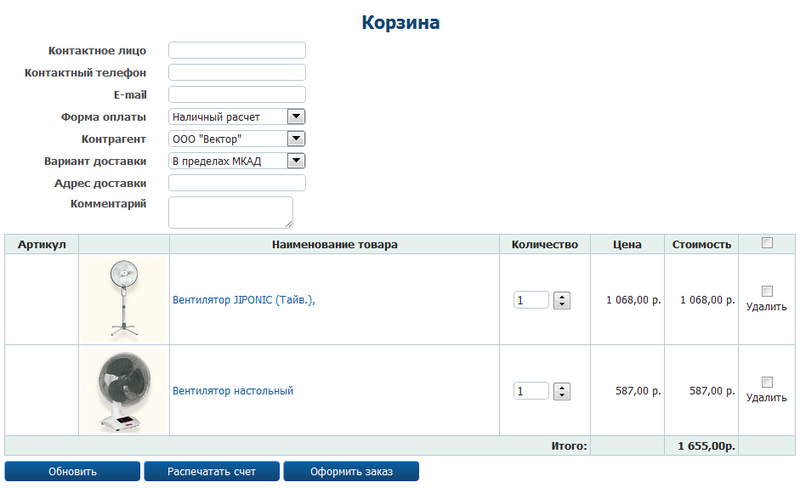What should the personal account of the Internet distribution system user look like?
To date, the most frequent customers of online distribution systems are purchasers of online stores. In the system of Internet distribution there is everything that they need: the remains of the supplier’s goods, order statuses, the ability to quickly form an order and print the invoice.
When we started designing an internet distribution system for the first time, we thought that the interface should be the same as that of a regular online store, but with more features and capabilities. So they did:

The result of the first test showed many shortcomings of this system.
The main ones are:
The time of order formation in the system is longer than in the case when the buyer of the online store forms an order in Excel and sends it to the supplier by mail.
Working with an order is not very convenient, because the interface of a regular online store does not even have such a thing as an “order”. First, the user has to fill the basket and only then place an order:

The interface does not allow to receive information on the remnants of the goods in the form in which the buyer used to see: article; title; quantity.
')
We decided to create an interface from scratch. Since the group of companies included both suppliers and online stores, it was easy for us to find out all the business processes between them and to design a new type of interface based on this.
The main conclusions that we made:
In the system of Internet distribution there should be the main entity: “ORDER”, which is the main work:
<img src = " habrastorage.org/storage2/ae6/a57/048/ae6a57048581c3fa292c046eedb1e497.png " alt = "order in the Internet distribution system '/>
Instead of working with balances in the directory, as it was before:

We offer to work with them in a separate window “Remains”:

Also, we have significantly simplified the work of the purchaser, giving him the opportunity to see the remnants immediately at the stage of order formation:
Option display residues 1:

Option display residues 2:

When designing the interface, we actively used tips from the book by Jeff Raskin “Interface”. We tried to take into account the peculiarities of human visual perception. Since, at any time, a person can focus only on one subject, we have divided the work in the system into several main sections, within which the purchaser can work as efficiently as possible without being distracted by secondary entities:

We are pleased to meet criticism and suggestions in terms of improving the current interface, which is available in the demo version
When we started designing an internet distribution system for the first time, we thought that the interface should be the same as that of a regular online store, but with more features and capabilities. So they did:

The result of the first test showed many shortcomings of this system.
The main ones are:
The time of order formation in the system is longer than in the case when the buyer of the online store forms an order in Excel and sends it to the supplier by mail.
Working with an order is not very convenient, because the interface of a regular online store does not even have such a thing as an “order”. First, the user has to fill the basket and only then place an order:

The interface does not allow to receive information on the remnants of the goods in the form in which the buyer used to see: article; title; quantity.
')
We decided to create an interface from scratch. Since the group of companies included both suppliers and online stores, it was easy for us to find out all the business processes between them and to design a new type of interface based on this.
The main conclusions that we made:
In the system of Internet distribution there should be the main entity: “ORDER”, which is the main work:
- creature
- deletion
- Union
- status tracking
- add / delete goods to order / from order
- creating an order template
<img src = " habrastorage.org/storage2/ae6/a57/048/ae6a57048581c3fa292c046eedb1e497.png " alt = "order in the Internet distribution system '/>
Instead of working with balances in the directory, as it was before:

We offer to work with them in a separate window “Remains”:

Also, we have significantly simplified the work of the purchaser, giving him the opportunity to see the remnants immediately at the stage of order formation:
Option display residues 1:

Option display residues 2:

When designing the interface, we actively used tips from the book by Jeff Raskin “Interface”. We tried to take into account the peculiarities of human visual perception. Since, at any time, a person can focus only on one subject, we have divided the work in the system into several main sections, within which the purchaser can work as efficiently as possible without being distracted by secondary entities:

We are pleased to meet criticism and suggestions in terms of improving the current interface, which is available in the demo version
Source: https://habr.com/ru/post/139788/
All Articles